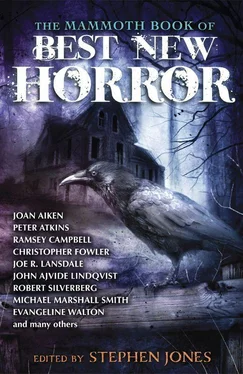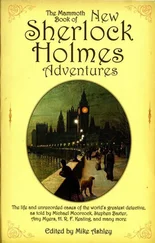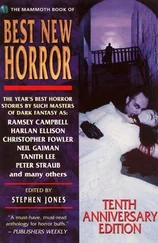His first collection of short stories, Lost Places , was released by Ash-Tree Press in 2010, and his second, Quiet Houses , followed from Dark Continents Publishing a year later. A further collection, Strange Gateways , is now available from PS Publishing, with another set to launch the “Spectral Press Spectral Signature Editions” imprint in 2013.
“‘The Ocean Grand, North West Coast’ first appeared in Quiet Houses , my portmanteau collection set as far as possible in real locales,” explains Unsworth. “This particular story is based on the Midland Hotel in Morecambe.
“The Midland has a long and chequered history, and when I first went there ten years ago it was just before it closed amid accusations of mismanagement and ownership wrangles. Back then, it was a perfect example of faded seaside glamour; it had the most beautiful fixtures and fittings, but they were falling to pieces.
“We used to go on Saturday evenings and have an after-dinner drink, sitting in a long glass corridor that extended across the rear of the hotel and gave out on magnificent views of Morecambe Bay and, in the distance, the Barrow headlands. It was always freezing in the sun corridor because the heating was never on and half the windows were broken, but it was worth it for the sight of the ocean and the sense of being somewhere that had a foot placed firmly within a magnificent past.
“The story came about because I’d read Barry Guise and Pam Brook’s excellent history of the Midland, The Midland Hotel: Morecambe’s White Hope (Palatine Books, 2007) and it made me think about how buildings made to be full of people might feel if they were closed and empty, and about art created to be viewed being alone and going slowly, claustrophobically mad.
“Gravette and Priest and the art they created for the Ocean Grand are very, very loosely based on the work and philosophies of the architect Oliver Hill and the artists Eric Gill and Marion Dorn, who designed and decorated the Midland originally. But mostly they’re my creations. Make of that what you will.
“The Midland, after years of closure, has been completely refitted and has re-opened, and looks spectacular. I’d urge you to visit and to have a drink in the new sun corridor or a meal in one of the restaurants.
“Me, I’m still a little nostalgic for those Saturday nights in the old sun corridor, when we had to keep our coats on because of the cold and when the wind danced in through the broken windows smelling of brine and sand.”
Arrival; Initial Impressions
MANDEVILLE TWISTED ON the key, hard, and felt it grate in the lock. With a final yank, it came around and then the Ocean Grand was open for the first time in fifteen years.
The central door was large and heavy and, even unlocked, it took him several hard shoves to open it fully; it had swollen from the years of disuse, clinging and screeching as it moved and cutting tracks through the dirt on the floor. Pieces of crumpled paper shifted away in the light breeze that entered the hotel around Mandeville. Of course, he thought, it wasn’t really the first time the building had been open for fifteen years, and he had to be careful not to romanticise the experience or what he found inside. Safety assessors had been inside only recently and security checks were carried out monthly, but he was the first outsider to gain entrance since it had closed as a working site in the early 1990s.
Actually, even that wasn’t quite true. A local television news team had accompanied one of the early safety crews and had filmed them placing boards over the wall murals and picture windows. Mandeville had a copy of the footage in his bag; in it, the unseen presenter talked about the glories and controversies of the art deco pieces that adorned the Grand’s walls whilst workmen nailed large boards over each piece “to protect it for the few months that the hotel was shut during its refit”. The “few months” had turned into almost two hundred, the refit had never occurred and the Grand had remained shut to everyone as it changed owners time and again in the intervening years. Until now.
Behind Mandeville, Parry began to unload the van, dropping their gear onto the cracked surface of the car park and telling a joke to Yeoman, the third member of the self-dubbed “Save Our Shit Crew”. Mandeville could already smell the sharp tang of Yeoman’s cigarette, and he smiled to himself.
Yeoman had said little on the journey, but his silence had become more pointed as they travelled and Parry refused to pull over for a rest stop, claiming that he was helping to break Yeoman’s habit by forcing him into periods of abstinence. Yeoman wouldn’t enter the Grand until he had smoked at least three cigarettes in the car park, Mandeville knew. It was an old routine, practised and refined over the previous years until they were all comfortable with it. Leaving them, Mandeville stepped forward into the Grand.
The foyer was large and circular, with the wings branching off through large, arched entrances at his left and right. Opposite Mandeville, the reception desk hugged the curved rear wall, its surface thick with dust. The great staircase rolled around from Mandeville’s right, clinging to the wall as it rose before letting onto the floors above the reception. He could just see the dark smears of the doorways leading to the upper bar and the outdoor sun deck.
Under his feet, the original wooden flooring was hidden under heavy linoleum, assuming it still existed at all. The light reaching him was dirty and dank; two storeys above him, the atrium’s great glass roof was mostly intact but had been covered from the outside with wooden sheets. Where these had peeled back or broken, allowing the light to enter, he saw a film of dirt and old leaves covering the glass.
Clicking on his torch, he let the beam play across the roof’s frame. It looked to be in fairly good condition, all things considered. There were rust patches, not unexpected given the Grand’s coastal location, and several of the more delicate sections of the pattern looked to be twisted out of shape. Some of the glass had been removed by the safety team; other panes, he knew, had fallen in long ago, the coloured glass swept up and discarded.
“Can we come in yet?”
“No,” said Mandeville. He wanted to savour this; he felt like a time traveller, stepping back into a past placed in storage and only now being brought back to use.
The Ocean Grand had been decaying for years, not just for the fifteen it had been closed and its ownership a fluid thing; even when it had been open, the rising costs of maintaining a building that had so many unique features had led to a legacy of mismanagement, cost-cutting and barely done repairs, of unique fixtures and fittings falling into disuse, of damage, of art lost and stolen and sold. The Ocean Grand was a part of England’s industrial and cultural heritage, abused and battered and only now receiving the attention it deserved.
Mandeville and his small team had to find out how bad things were in the Grand, catalogue what remained, and work out what could be saved and what was gone.
Even in the foyer, Mandeville could see evidence of the neglect. There should have been ten balustrade tops in the “primitive figures” style, cast in metal and spaced every five feet up the staircase, but three were missing. Sections of the reception desk’s ornate wooden panelling had been replaced with plain wood sheets and, worst of all, the large panels of the Gravette mural that should have faced the guests as they approached the reception desk were gone.
Mandeville knew two were in storage in London; the other two were missing, presumably destroyed or taken when the mural was removed in the early 1980s rather than pay for its professional renovation. There was always someone prepared to buy an original Gravette, even one that was painted on a twenty-foot by six-foot wooden panel and which was only actually a quarter of the whole piece.
Читать дальше










